How to Raise a Bulldog | The Ultimate Bulldog Guide for Owning, Caring and Training The Best Puppy
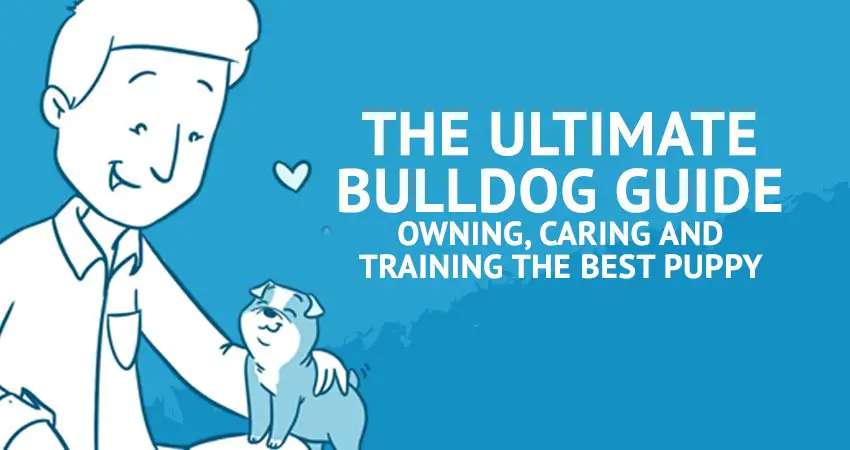
Have you decided to bring a bulldog into your home and raise them with your family? One of the great dogs to have is the English bulldog or the French bulldog.
These kinds of dogs are loyal, pretty laid back, and loves to have fun around. However, they need a little different TLC compared to other dogs. If you are considering to bring one home, or you just brought one, this bulldog temperament guide can help and give you some information, tips, and advice about bulldogs.
You are going to find everything that you need to know about the bulldog temperament and to take care of a bulldog.
Whether the English or the French bulldog you think is the right one for you.
This guide is going to walk you through decisions and help you to learn how to take care of them as a puppy, some of the significant health concerns, its temperament, tricks for training in their first few months, and even the best food that will help them grow big and strong.
If you are ready to add a bulldog to your home, pick up this guide, and learn as much as possible.
You will be able to find the answers to all your common questions so that you can give the bulldog all the love, care, and attention that they deserve to live a great life.
Free bonus: Download this ultimate Bulldog guide as a PDF. Easily save it on your computer for quick reference or print it for your bulldog guide.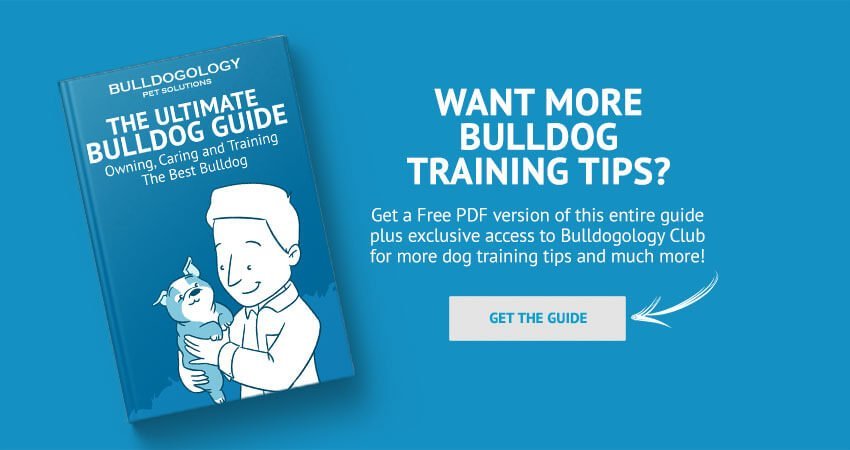
The Basics of Owning a Bulldog
Bringing a bulldog puppy into your home can be a really momentous occasion for your family.
A bulldog is loyal and a great companion for you to enjoy for many years. But before you bring this puppy into your home, it is important to know some basics about the puppy so you can give them the best care possible while raising them.
We’ll take some time to talk about the basics of owning a bulldog so you can be as prepared as possible.
Where Did the Bulldogs Originally Come From?
The very name ‘bulldog’ conjures up images of a large dog with a grumpy face and a tough persona. However, it is not so, for the bulldog is a big ‘softy’ and behind all those wrinkles and gruff appearance is a gentle dog waiting to shower its love on its humans.
But bulldogs weren’t always “softies” and their rich history shows them as stocky, sturdy dogs with a solid, foursquare stance and a face that says: Bring it On!
Let us find out how this breed transitioned from bull-baiting to the sweet, household companion that it is known for today.
Old English Bulldog History
English bulldogs were developed for the sport of bull baiting in England. As its name indicates: bull-baiting means fighting a bull in the ring.
The early English dogs were bred to have a certain height, weight, and even a specific temperament to help them fight aggressively and breeders carefully selected the dogs to fit this mold.
Bulldog breeders wanted these fighter dogs to have a short height so it would be difficult for the bull to spot them in the ring. After all, the bull could easily lift and toss the bulldog in the ring. As a result, the Old English bulldogs were shorter than the ones we see today.
Bullies (as their breeders called them) were made to have a certain weight and build so they could withstand the occasional toss.
Fighter bullies also had shorter noses compared to the modern bulldogs. This could help them get a convenient grip on the bull’s face without their nose getting in the way. Often, the nose had to be set back from the muzzle and also turned up so the dog could breathe while it maintained a grip on the bull.
The wrinkles were also a distinctly necessary feature for the bull-baiters; they directed the flow of the bull’s blood away from the dog’s nose and eyes.
Thankfully, this cruel sport was put to an end when breeders started maiming their bull-baiting dogs to earn more money from the bets.
This did not result in the breed’s demise as people still wanted bulldogs as pets for their temperament. So, breeders and bulldog fanciers started developing them while keeping out the viciousness and tenaciousness out of their personality.
The result is the sweet bulldog of today that we all love and admire. This is a tough-on-the-outside, but a marshmallow-on-the-inside dog that makes a great house pet!
Naturally, the modern bulldog has retained some of its spiritedness and determination – you simply cannot argue with your bulldog! But most bully parents will tell you that their pet is far cry from the English bulldog origin!
French Bulldog History
The history of the French Bulldog breed is a little convoluted because there are several different stages of breed development spanning across three countries – England, France, and the United States.
The foundation for the modern breed, the Bulldog, comes from England but the smaller bulldog that came to be known as the French type was, of course, developed in France.
French bulldog origin can be traced back some 175 to 200 years.
After bull-baiting was brought to an end, some breeders started aiming for smaller or toy versions of the breed. The French bulldog original look was a dog weighing less than 25 pounds.
This smaller version started gaining popularity among the French. By the 19th Century, French bulldog breeders began to develop a near-uniform looking ‘Frenchie’ with a compact body, short legs, and without the extreme undershot jaw seen in larger bulldogs. Some of these small dogs had erect ‘bat-like’ ears while others had rose ears.
When American travelers saw the cute Frenchies, they started taking them back to their continent. Soon selective French bulldog breeding started taking place in the United States.
In the USA, the breed’s population declined severely during the Great Depression mainly because births were rather difficult for bulldog bitches due to their short statures. By the 1980s, revival efforts took place and by 2005, nearly 5000 bulldogs were registered.
French bulldog’s original purpose was that of a companion and show dog. Today, the breed continues to gain popularity as a house pet and is even included in the top 15 popular dog breed list in the United States.
You have learned about the illustrious history of the French and English bulldogs. The American bulldog and English bulldog were both developed from the bull-baiting Old English bulldog breed – the same one that contributed to the French bulldog origin. Having an understanding of this rich history will help you get an insight into some facts about your pet’s temperament and personality. These are important aspects to consider when you train your bully!
The Difference Between an English and a French Bulldog
 A common question that a lot of people have about the bulldog is what the difference is between the English and the French bulldog.
A common question that a lot of people have about the bulldog is what the difference is between the English and the French bulldog.
Here is a brief overview to help you show what significant changes the two breeds have and how can you tell the differences.
English Bulldog
Here are some bulldog facts about this bulldog, they are short, thick, and really strong dogs.
Most of them will come in around 50 to 60 pounds, although some of the larger ones can be around 70.
Their faces are usually flat shaped, but some that underwent poor breading usually have small muzzles. Most of the English bulldogs don’t have a full-length tail and have stayed short since they were born.
Some have longer tails compared to the usual ones, but if they do, it usually looks like a corkscrew.
They can come in different colors, but most purebreds don’t come with a red-colored nose unless they have a rare genetic disorder which is uncommon.
French Bulldog
French bulldogs are a smaller type of English bulldogs. They usually weigh around 28 pounds, but most of them weigh less.
Some are bigger because of poor breeding. Some are small as a pug and are mistaken as one at times, especially if they had in-born deficiencies.
French bulldogs come in a variety of colors, and some of them have small muzzles.
Often, the best way to distinguish them from English bulldogs is by their smaller size and pointy ears like a bat.
Bulldog Facts: 9 Exciting Facts You Need to Know
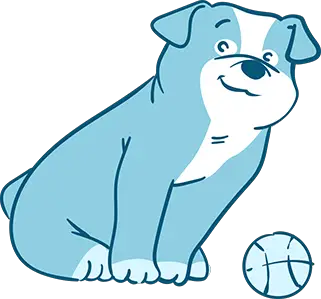 Bulldogs may look like the simplest dog breed out there. Yet, each type of bulldog has its own extensive history with various other secrets you may be unaware of!
Bulldogs may look like the simplest dog breed out there. Yet, each type of bulldog has its own extensive history with various other secrets you may be unaware of!
So, if you’re one of those people who absolutely adore bulldogs, then unravel the secrets about one of the most popular dog breeds.
If not, well these fun facts about bulldogs will make you love them.
#1 French Bulldogs Have Got Their Roots In England
This definitely comes as a surprise, doesn’t it?
Now, there’s no hardcore evidence to track back their origin. However, it is said that lacemakers in England loved to have English bulldogs.
So, here’s the whole story.
When the lace-making industry moved to France, they took their bulldogs with them.
Later on, these English bulldogs mated with the terrier breed and gave rise to French bulldogs!
Check out this article blue French bulldog if you want to learn more about some interesting facts about them.
#2 English Bulldogs Were Used For Fighting Bulls
Bulldogs may seem like the most innocent breed of dogs. Yet, the reason and history of why they were bred is more than appalling!
During the earlier centuries, bull baiting was a common sport in the United Kingdom. The people then used dogs, such as bulldogs for this purpose.
Bulldogs had to bend low to try to bite the nose of a bull. Sometimes, they succeeded.
However, the problem was that certain bulldogs got injured severely during the play, which is why the rulers soon banned this cruel sport.
Well, now you know why we call these dogs bulldogs!
#3 French Bulldogs Have Difficulty In Flying
Are you planning to fly overseas with your French bulldog?
Hold up! Here’s something you may want to know.
Unlike other dogs, some breeds such as pugs and French bulldogs have shorter snouts which cause difficulty in breathing.
Additionally, their pushed-in faces may also become a cause of concern. Due to these reasons, it is unhealthy for your French bulldog to fly.
In fact, some airlines have also banned these dogs from flying.
So now, what can you do? Well, there are special pet airlines such as Pet Jets. They can take care of your dog properly and fly to you!
#4 American Bulldogs Were Used To Guard Farms
If you have an American bulldog, here are some American bulldog facts.
American bulldogs were actually farming animals.
Do you know why?
It is because the farmers used American bulldogs to hunt wild animals, pull wagons, and also protect the livestock.
Wait, there is more you need to know!
American bulldogs are also used to preying on certain animals like cows or horses. The reason is their natural instinct was to drive these animals away from the fields.
So, if you have any of these cattle animals, make sure you train your bulldog to socialize with them.
#5 French Bulldogs Aren’t Used to Criticism
Sometimes, dogs resemble humans. So do French bulldogs.
Just like many of us, French bulldogs are not used to harsh criticism, especially when it is coming from their beloved ones.
Due to this particular reason, many people advise that while training a French bulldog, you should not get too harsh on them.
For example, scolding them or shouting at them if they end up peeing or pooping on the carpet.
So, the trick is to encourage them positively to help them train and grow better!
#6 English Bulldogs Were Almost Extinct
Yes, you read it right! Your favorite breed wouldn’t have existed if not for a few people.
Do you want to know the full story? Read on!
As mentioned above, English bulldogs were used for bull-baiting. However, when the sport was banned, people didn’t go for the breed anymore.
English bulldogs weren’t bred as they used to.
Luckily, there were a few people who took up the task of loving and caring for these bulldogs.
In fact, plenty of people even took English bulldogs to other countries such as the United States and Germany. Here, these dogs were used for herding related activities.
#7 French Bulldogs Experience Difficulty In Swimming
Another thing to keep in mind is, french bulldogs experience difficulty in swimming.
The reason is similar to the third point! French bulldogs have small snouts. So, during swimming, they’ll have to push their head way above the water, which can potentially cause shortness of breath.
The bottom line is that it is always better to not take your French bulldog to the beach or the pool as swimming is just not their thing!
#8 American Bulldogs Are Friendly
Well…
This may come as a shocker but American bulldogs can get pretty friendly!
There are many people who think of American bulldogs as aggressive due to their size and natural instinct.
Yet, once you get acquainted with them, they’re the friendliest of the lot!
#9 English Bulldogs Are Self-Sufficient
One of the best things about English bulldogs is how self-sufficient they are.
Unlike other dog breeds, English bulldogs can come out of any problem without their owners’ help. This definitely makes it easy to take care of them.
You may discover various new things when it comes to bulldogs. The above fun facts about bulldogs were just a few of them! So, keep on reading more every day if you are willing to know more bulldog facts. We hope you enjoyed reading these interesting facts about bulldogs. If you did, do write your comments below or share the post!
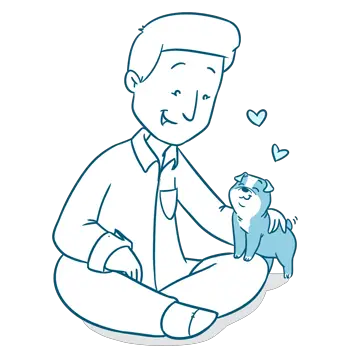 The Bulldog Temperament
The Bulldog Temperament
When it comes to the English bulldog, you are going to get a loyal friend for life.
These dogs are very friendly and docile and can even do well with young children if you have some around the home.
They are often willful and a bit stubborn, but if you get started on the training right away, this usually isn’t much of a problem.
When it comes to the French bulldog, you are going to get a puppy who is really affectionate and playful.
These dogs have a lot of energy and like to be social, but they do have the patience to deal with younger children when around.
You need to be ready to play a lot and be active often to keep up with this puppy.
Now that you know some of the basics that come with the bulldog, it is time to learn some of the specifics of how to keep up with and care for your new furry addition.
Ways to Get My Stubborn Bulldog to Calm Down
Sometimes a bulldog can be really hyper and it is hard to get them to calm down. And since the bulldog is a pretty stubborn type of dog and this can make it even more difficult for you to get them to listen and do what you would like them to.
Often, your puppy will outgrow this kind of behavior, but you should start working on the proper training early on so they learn how to behave before they drive you crazy.
To avoid this hyper puppy behavior, you should make sure that you start training the puppy as soon as you bring them home.
If they are hyper just when other guests come over, put the puppy in their cage, or where their bulldog bed is placed, and then once the people are sitting down and comfortable, slowly bring them out and help them to get comfortable.
You should also teach them how to lay down or stay as soon as possible so that they remain calm. Plenty of exercise and playtime will help to keep the puppy calm as well. We also recommend using calming treats for dogs if your pup prefers treats!
Are Bulldogs Good Pets?
Bulldogs are wonderful pets to bring into your family.
While some of them can be a bit stubborn at times, they are really loyal pets that love to be around families.
The bulldog loves to play and is really loyal to their family.
They are great with young children as they like to bounce around and play a lot of the time, but they have the patience to not get angry when children get a bit wild.
Whether you are on your own and want a loyal companion to be by your side or you are interested in finding a great addition to your growing family, the bulldog, both the French and English variety, is a great choice.
Getting Started with Bulldog Tips
Ready to bring your bulldog home and get a great start on your new relationship with your furry new friend? Here are some great tips to help you to get ready for the bulldog and to ensure they are going to fit in well with your family and home life.
Proper Bulldog Training Tips
Training your bulldog is similar to how you will train any other puppy.
If you have brought other puppies into your home in the past, you will be able to employ the same kind of training techniques that you used in the past.
For those who have never brought home a puppy before, here are some basic tips that you can use in order to properly how to train a puppy and get them to be great in your new home:
- Become the boss—if you aren’t the boss, the puppy will assume they are, and then you have trouble. Ensure that the puppy listens to you and never gets the run of the house.
- Use positive reinforcement—positive reinforcement, such as treats, praise, playtime, and walks will help your puppy to learn what they are supposed to do with you. It is much more effective than using options like hitting.
- Never hit—hitting a dog at any age can lead to aggressive behavior and is not going to get the desired results that you are looking for.
- Have the puppy eat when you do—but make sure that you are the first one to eat. Never leave the food on the floor for the puppy to eat whenever they want.
- Walk with the puppy in front or behind you—the puppy should never be the one leading on a walk and you should never have a tight leash.
- Start training early—you should start out with the training right when you bring the puppy home. The sooner the better to ensure they know who is boss and how they should act.
- Consider crate training—crate training allows your puppy to have their own special corner in the home to call their own. Whenever they get scared, they can go to this location. It is also a great way to keep them in one spot if you have to be gone all day for work.
- Treats are great for trick training—offering up treats and a lot of praise when you are teaching your puppy easy commands can make it easier. You will be able to slowly go off the treats and use just the praise after giving a one-word command and your puppy will still obey.
- Establish rules early—as the owner of the puppy, you get to decide on the rules. But make sure that you establish the rules early on and stick with them. This avoids confusion with your puppy and ensures they behave the way that you want.
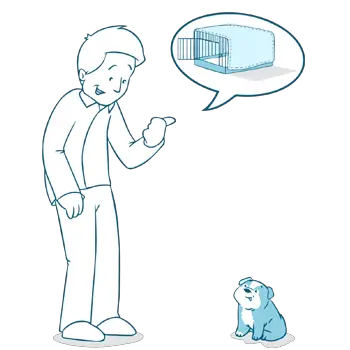
Bulldog Training: Everything You Need to Know About Some Basic Commands
You can easily train your bulldog to follow certain dog commands by giving them your time, staying patient, and encouraging them at every step. You can also offer your dog some tasty treats and other rewards for obeying your commands. Trust us, once they learn how to listen to you, it is an easy play.
Bulldog training is one of the essentials of having a healthy and good relationship with your dog.
Do you know why?
Let’s take an example of teaching some basic commands to your bulldog. Knowing some commands can make it easier for both of you to understand each other.
So, if you apply some of the tips given below, you can definitely train your bulldog to follow commands!
Things You Require for Teaching Your Dog Some Basic Commands
When it comes to teaching your bulldog some basic commands, there isn’t a lot that you need except:
Wait, there are just a few important things to note though!
Stay Patient and Firm!
Firstly, be extremely patient and consistent while dealing with your bulldog.
Make sure you don’t scold or shout at them!
The reason is that they may stop listening to you or even get anxious which isn’t healthy.
But…stay firm and don’t spoil them.
Set Goals and Schedule
We recommend setting some goals and schedule to have an effective session.
Get Some Rewards
Another thing you can get your dog is some nice dog treats. These treats can act as a reward whenever your dog listens to your commands well.
Easy Guide on How to Teach Your Bulldog Some Basic Commands
There are some of the basic commands that you can teach your bulldog without putting in a lot of effort.
So, let’s get into it, shall we?
1. Make Your Dog Sit
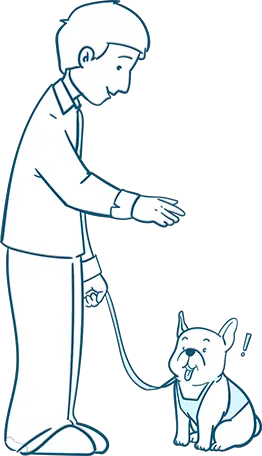 You can easily make your dog sit when they get too excited, by using the ‘sit’ command.
You can easily make your dog sit when they get too excited, by using the ‘sit’ command.
So, here’s the big trick – keep a dog treat handy and follow either of the two methods!
Method 1:
- First, kneel to the level of your bulldog.
- Take a treat and place it near your bulldog’s nose.
- Then, gently take the treat over their head, and say ‘sit’.
- This way your dog will learn to sit when you command them.
Method 2:
- Again, sit in front of your dog.
- Keep a hand on their chest and one on their back legs
- When you say ‘sit’, gently pat or squeeze their chest to make them sit down.
Keep following this routine and giving your dog treats to encourage them!
2. Make Your Dog Lay Down
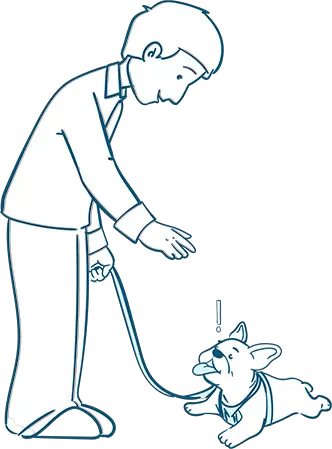 The next basic command that can come in handy is ‘lay down’.
The next basic command that can come in handy is ‘lay down’.
Do you want to know how to do it?
Well, the below-mentioned methods work magic!
Method 1:
- Firstly, kneel and keep your left hand on your bulldog’s shoulder.
- Then, place the other hand behind their front legs.
- Say ‘lay down’ and slowly press on their shoulders.
- Slide down your dog’s front legs gently till your bulldog is lying down.
- Slowly stroke their back and encourage them to stay this way.
- To get them up, again use a command.
- Then, reward your dog after every repetition
Method 2:
- Place your hand on the shoulders of your dog.
- In your right hand, keep a treat handy.
- Keep the treat between your dog’s legs and pull it away slowly.
- Once your dog is lying down properly, give the treat to them.
Continue doing this repeatedly until your bulldog gets used to following the command properly.
3. Make Your Dog Stay In The Same Position
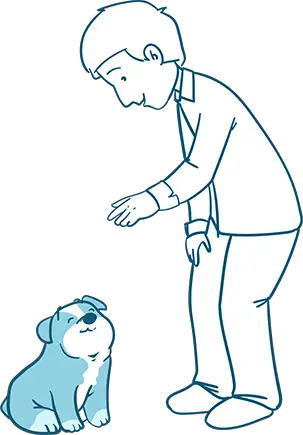 You’re probably thinking what’s the use of the ‘stay’ command.
You’re probably thinking what’s the use of the ‘stay’ command.
The answer is – the ‘stay’ command is quite helpful when you’re training or exercising your dog. It will help your dog stay put rather than getting back in the original position.
Wait, there’s a catch!
There is no particular method to keep your dog in position. The main requirement is to have both starting and ending commands so your dog will know when to stop.
But…
Unlike other approaches, make sure you don’t keep giving treats to your dog to make them stay in the same position.
The reason?
Well, your dog will not work for their own self but rather for the treats. We don’t want that now, do we?
4. Make Your Dog Come to You
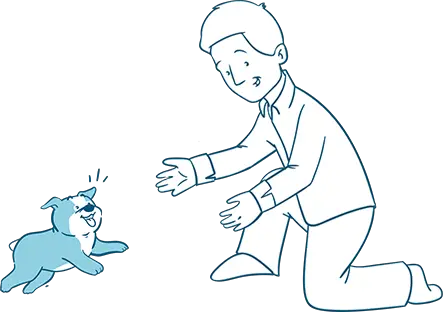 Another important command your dog needs to know is the ‘come’ command.
Another important command your dog needs to know is the ‘come’ command.
This command can get extremely useful if your dog runs away somewhere or is hiding from you. It also comes to use when you want to start their potty/house training.
So, instead of just shouting your dog’s name, you can command them to come to you.
Here’s how it works:
- Consider putting a collar or a leash on your bulldog.
- Then, gently pull the leash while getting down to your dog.
- Tell them to come to you by commanding ‘come’.
- Once your dog does, offer them a treat or reward.
You can try removing the leash or collar once you’ve practiced it enough times. If it is successful, then remove the leash permanently.
For every bulldog owner, teaching their dog some great commands can come in handy in plenty of situations. So, what are you waiting for? Set a schedule and get going!
French and English Bulldog Potty Training: Do’s and Don’ts You Need to Know
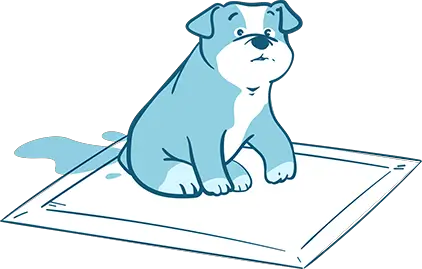 You may wonder how many efforts you may have to put in for bulldog potty training.
You may wonder how many efforts you may have to put in for bulldog potty training.
Wait, there’s something you need to know!
Potty training an English or French bulldog can take about 4-6 months.
Still…
If you follow certain effective tips and avoid a few things, bulldog potty training won’t even take a month!
Read on to save up on your time and efforts by following the below do’s and don’ts for bulldog potty training.
Do’s for Bulldog Potty Training Practice
The key to potty train a bulldog lies in patience and consistency. However, there are a few more things to keep in mind.
So, now that you’re here, given below are the big secrets for French or English bulldog potty training.
Let’s begin, shall we?
#1 Set a Fixed Routine For Bulldog Potty Training
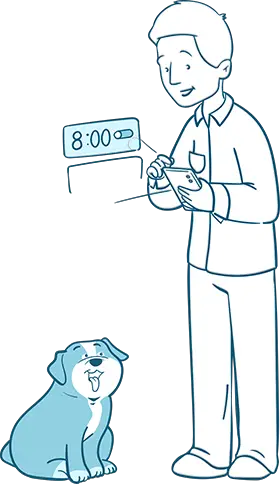 The best way to potty train a puppy is by having a potty training schedule.
The best way to potty train a puppy is by having a potty training schedule.
Here’s how it works:
Firstly, you need to take your bulldog out just after they’ve woken up in the morning. Similarly, you’ve to do so after they’ve woken up from their naps.
The reason?
Well, this will help your bulldog to know that they need to do their business whenever they wake up.
There’s more to it.
Even before you put your dog to bed or go out for an extended period of time, you should consider taking your dog out for potty business.
But, what’s the point? The point is that your dog will not end up creating a huge mess when you’re out unless you wish to clean their poop!
#2 Take Your Dog Out at Regular Intervals
Did you know that when you house or potty train a puppy, you need to take them out after every hour or so?
The same stands for a bulldog potty training session.
Here, the bottom line is that when you take your bulldog out after every half or an hour, they will slowly start developing the habit of going out and doing their business.
#3 Fix Up Their Diet
Now, you may think about what diet has got to do with potty training.
It does scientifically!
Bulldogs, especially English or French bulldog puppy, have a small digestive system. When you give them plenty of food, it can disturb their systems and cause inconvenience in your potty training.
So, what’s the solution?
Instead of giving your bulldog puppy two meals twice a day, make it three smaller meals thrice a day.
Oh, and there’s more to it!
For french bulldog potty training, take your puppy out after fifteen minutes of eating for urination. When it comes to pooping, taking out your dog after half an hour seems like the perfect idea!
#4 Give Your Dog Rewards During Bulldog Potty Training
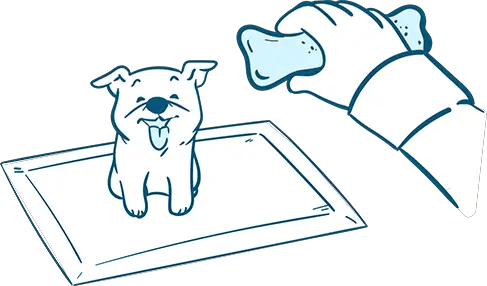 Dogs love to get rewards, just like us. So, for English bulldog potty training or French, consider giving your dogs some nice doggy treats.
Dogs love to get rewards, just like us. So, for English bulldog potty training or French, consider giving your dogs some nice doggy treats.
But here’s a catch…
As dog treats contain many food colorings and unhealthy ingredients, they may harm your dog. However, a quick solution is to only go for those treats that offer healthy yet tasty composition.
The bottom line is your dog will love the encouragement and will cooperate with you.
#5 Consider Getting Extra Helpful Items
For bulldog potty training, there are some amazing helpful items available everywhere.
Let’s say, for example, a crate. A crate allows you to potty train your dog inside your house before you take them outside. You can also keep a good eye on them.
You can also consider getting the best pee pads for dogs from Bulldogology or pet stain odor remover spray.
You know why? These items will help in reducing the hassle of cleaning up if your bulldog makes a giant mess!
Don’ts for a Bulldog Potty Training Practice
Beware!
Your bulldog potty training sessions may become extremely difficult if you do certain things.
#1 Don’t Punish Your French or English Bulldog
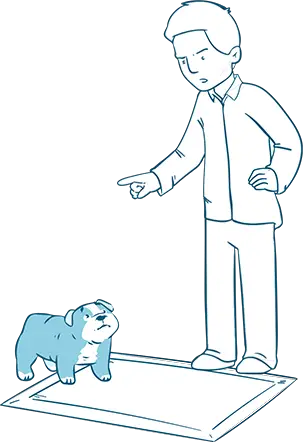 Did you know that just like us, dogs also experience feelings of anxiety and fear?
Did you know that just like us, dogs also experience feelings of anxiety and fear?
Now, this is where you need to become cautious.
If you scold or even worse, hit your dog if they make a mess while potty training, they can develop such feelings.
So, here’s what you can do instead. Try again and when your dog gets it right, reward them. This way they’ll love you more rather than fearing you.
#2 Don’t Over Spoil Them
Yes, while potty training your dog, you may end up over spoiling them.
This usually happens when you give your dog a lot of rewards and treats. Now, I know you adore your dog but try to limit the treats.
The issue with this is that your dog’s expectation will keep on rising and they’ll always want more.
The trick is to encourage them rather than making them greedy!
#3 Don’t Lose Your Attention or Consistency
Depending on your dog, it may take some time for you to potty train them. So, never ever stop being consistent.
Likewise…
Stay attentive and don’t forget to check for signs like sniffing, circling, and anxiety in your dog. These signs are proof that your dog is looking for a spot to poop!
In the end, it all boils down to staying patient and consistent.
Trust me, once you bulldog potty training sessions are over, you will have no stress! You can go anywhere without worrying about your dog or coming home to a messed up house.
So, I hope you enjoyed the list!
You may also write down your views below and share the article if you liked it.
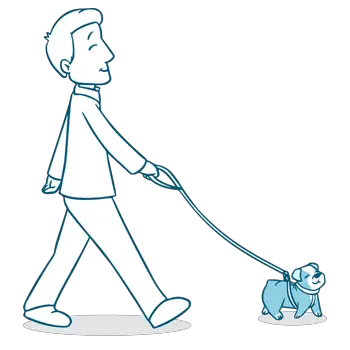 Do Bulldogs Need Special Collars?
Do Bulldogs Need Special Collars?
It is a good idea to purchase a special collar for your bulldog.
For both English and French bulldogs, using a harness instead of just the collar that goes around the neck is usually the best option.
Regular collars are not that effective for bulldogs considering their body build. It is all fun and games until the collar gets tight resulting in physical harm.
On the other hand, a harness can let you take full control over your pet when walking. It is safe, and causing bodily harm is unlikely as it goes around their chest.
Make sure that you pick out the best dog harness that is thick enough for your breed.
12 to 16 inches small harness is ideal for French bulldogs, while a bigger harness fits best for English bulldogs as they can grow even more.
 Can My Bulldog Swim?
Can My Bulldog Swim?
A common question that people ask is can bulldogs swim? Some want to take their puppy to a lake and are worried if it can swim or might overheat for too much sun exposure.
Bulldogs are not designed to swim.
Know that swimming is not for bulldogs, but you can let them move around wading in a little a shallow water where they can stay cool on a hot temperature day.
They can’t swim in big pools, lakes, or other large bodies of water. Bulldogs find it difficult to swim, and most of them will slowly sink like a rock.
Taking them out for swimming is still possible by making sure you keep an eye on them all the time. The safest way to do is to put a life vest for dogs on them.
The alternative would be to use a bulldog life jacket, which can help your bulldog puppy to easily swim.
Getting To Know The Bulldog Health
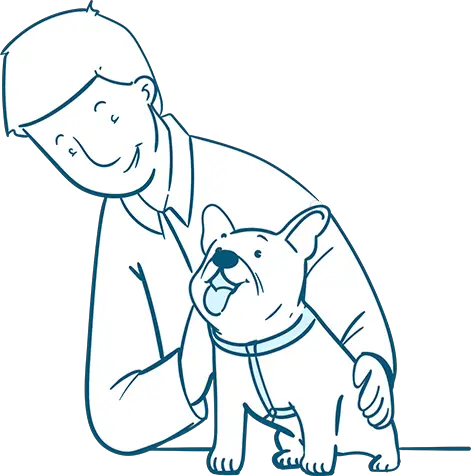 Lots of different factors that you should keep in mind when it comes to a bulldog’s health.
Lots of different factors that you should keep in mind when it comes to a bulldog’s health.
Making sure to check each of these things as you go through your grooming process to ensure you don’t miss a job to keep your bulldog in good health.
Are English Bulldogs Unhealthy?
One of the common concerns about English bulldogs is their health problems.
While they may be more susceptible to have health issues, it often has to do with the kind of care you provide to them.
One of the examples is they easily overheat compared to other dog breeds.
However, keeping them inside when it’s hot, limiting the time exposed under the sun, and visiting the Vet regularly will help to keep them healthy.
But make sure to keep an eye on them, and if you think they are not feeling well and has been acting odd, take them to the nearby Vet right away.
Most of the health concerns that come about English bulldogs are caused by improper handling of owners. Many owners are not ready for the responsibilities to take well care of this kind of dog.
This is how a simple problem can quickly get out of hand. If you provide the right kind of care to your English bulldog, they can stay as healthy as any other dog breed.
What is the Average Lifespan for a Bulldog?
Bulldogs don’t have a long lifespan compared to some other breeds. Their average lifespan is between 8 to 10 years.
Oftentimes, the breed’s shorter lifespan can be attributed to poor and complicated health issues such as having difficulties breathing because of their body build, or acquired genetic and physiological diseases.
Common Health Concerns With Bulldogs
Bulldogs are susceptible to many health issues if you don’t give them the proper help they need. Some of the most common health concerns that you should keep an eye on include:
Vomiting
Vomiting is a reason for an upset stomach. For this, you can give them Pepto Bismol, an antacid medication, with a dosage based on their weight. This is ONLY to treat TEMPORARY discomfort. It is always best to leave the dosage and formats to a veterinarian.
On an important note, determine first the reason why your puppy is vomiting. It could be a natural body response from its first car ride, or it has simply eaten something unfamiliar. Make sure to cover your seats with Bulldogology dog car seat covers in case of messy rides.
If the vomiting continues for over 24 hours, it is best to take to a nearby vet clinic. Giving Kaopectate can also help temporarily for diarrhea.
Hot Spots
Hot Spots are itchy spots that are red and irritated. Flea allergies, insect bites, and allergies are a few of the several reasons why dogs get hot spots.
Cleaning the area using shampoo–make sure to rinse it well, applying aloe and lanolin can help to clear out the area.
Interdigital Cysts
Interdigital Cysts appear read and swelling in between a dog’s toes. Taking a thorough check on their paws will help you a lot.
If you find foreign objects such as a thorn, make sure to clean the area out.
There are a few home remedies you can do. Use a warm bath with some Epsom salt on the paw and make sure to keep it dry afterward.
Apply Preparation H is also recommended.
Fungus Spots
Fungus Spots are like dry hot spots. It would be best to clean the scabs away and wash the area. Applying anti-fungal ointment will help. This usually happens around their wrinkles, most dogs with winkles have this problem and can be helped with dog wrinkle wipes.
Facial Acne
Like humans, dogs can get pimples and acne, too! This is because excess oily sebum and dead skin cells mixing together.
Dog acne looks like a little red bump usually around the muzzle. Using benzoyl peroxide can help, but consulting a veterinarian is best to avoid complications.
Insect Bites
Bulldogs are susceptible to getting insect bites. If they are stung by an insect, using Benadryl often works out well.
It would be best to check on them every 30 minutes. Using an ice pack on the area can keep it from swelling, and make sure to remove the stinger if stung by a bee.
Heat Sensitivity
One of the things you should need to keep an eye on a bulldog is their heat sensitivity as getting heatstroke is common for them.
Please make sure not to overexpose them under the sun as the weather could get hot for them any time of the day without us knowing.
Taking them for an early morning walk or after sunset is advisable. Always remember to keep them hydrated.
If you notice that their tongue starts to turn blue, are panting heavily and aren’t moving much, taking them indoors right away and give them water to drink. Be vigilant to notice any signs of vomiting; it could become a choking hazard.
Limiting their sun exposure, especially in summer is advisable.
Common Bulldog Eye Problems and How to Avoid Them
 Bulldog eye problems can occur anytime so it is your responsibility to check your pet’s eyes from time to time. Watch out for injuries or infections and if you notice a problem, have it treated right away.
Bulldog eye problems can occur anytime so it is your responsibility to check your pet’s eyes from time to time. Watch out for injuries or infections and if you notice a problem, have it treated right away.
If you are wondering how to spot French bulldog eye problems, then check out the common bulldog eye issues and their solutions:
Common Bulldog Eye Issues
Cherry Eye
Cherry eye in bulldog is a common issue. It can begin as early as 4 months old.
In addition to upper and lower eyelids, dogs have a third eyelid. In cherry eyes, a swollen gland pops out from under the third eyelid. It looks like a cherry, hence the name.
Thankfully, this condition is completely treatable, and if you catch it early on, your vet can administer medicines to lower the swelling.
Check out bulldog cherry eye treatment here.
Please note that, if left untreated (or if not properly treated) bulldog cherry eye can lead to dry eyes or KCS.
Dry Eye/Keratoconjunctivitis Sicca (KCS)
Dry eye/KCS is a bulldog eye infection that occurs due to abnormal tear production.
Your bully needs tears (just like all of us do) to lubricate and clean out the eyes. Without tears, your pet could suffer from constant eye irritation.
Over time, dry eyes could lead to corneal bulldog eye ulcers, corneal scarring, and eventually, blindness.
Bulldog dry eye treatment includes the administration of eye medicines and artificial tears.
Corneal Ulcers
A corneal ulcer (also sometimes called a “scratch on the cornea”) is an injury to the surface of the cornea that may be superficial or deep. There are many potential causes of corneal ulcers in bulldogs – the most common being direct trauma.
KCS/dry eye, entropion, and distichia (when eyelashes rub against the cornea) can also cause bulldog eye ulcers.
Superficial ulcers usually heal with time and with proper treatment.
If deeper ulceration is present, a bully will need longer treatment with frequent vet visits.
Bulldog eye ulcer treatment includes topical antibiotics, and, in some cases, a small surgical procedure to create a conjunctival flap.
Entropion/Inward Turning of Lower Eyelid
This is one of the common bulldog eyelid problems.
It causes the eyelashes to rub against the cornea leading to scarring, ulceration, and severe corneal irritation.
If you notice your pet with an unusual squint, redness, and pain (bully will try to scratch or rub the eye often), then it could be entropion.
Do not ignore this condition, for, if left untreated, a bully could develop more severe eye problems, including blindness.
Entropion treatment includes antibiotic medicines and surgery.
Ectropion/Loose Lower Eyelids
Ectropion is also one of the common French bulldog eyesight problems. It causes the lower eyelids to loosen and turn outward. This exposes the inner eyelid which can then become inflamed.
Do not ignore this condition, for, if left untreated, it can lead to reduced tear formation which, in turn, causes dry eye/KCS.
As the eyelid continues to sag, it becomes susceptible to exposure to allergens like pollen, dust, etc.
This can cause bulldog eye stains and bulldog eye allergies. To clear the irritation, your pet might constantly scratch the eye which can lead to infections, scarring, and even blindness.
The treatment goals for ectropion are to restore normal lid using a lid-shortening corrective procedure.
Abnormal Eyelashes
Eyelash abnormalities are common bulldog eye problems. They can include extra eyelashes or misdirected eyelashes on the edge of the eyelid.
A bully with abnormal eyelashes might show symptoms like watering eyes, corneal scarring, and slow-healing sores. Eyelids sticking out in an unusual position can cause severe pain to your pet.
The good news is that this condition is completely treatable. Your vet can surgically cut out or freeze the abnormal eyelash follicles to give your pet much-needed relief.
Glaucoma
As in humans, glaucoma in dogs causes increased pressure within the eye. If left untreated, it can lead to blindness. Glaucoma can occur in older bulldogs although disease and injury can cause the condition in younger dogs as well.
Glaucoma needs pressure-reducing treatment for life. If the pain is too intense, then your pet might need some drastic surgical procedures.
Cataract
In bulldogs with cataracts, the eye lens becomes cloudy and foggy. An older pet could develop this eye condition which leads to vision loss. You might see your pet bumping into things.
Cataracts need surgical intervention. The good news is that this is a standard procedure and your dog’s vision will improve with the surgery.
How Soon Do I Need to get my Bulldog in if I Notice an Eye Problem?
Your intelligent bulldog will usually find a way to communicate with you about problems it may be experiencing.
Common bulldog eye problems like allergies and discharge usually heal on their own.
However, if you notice your pet pawing its eyes too often, it can cause serious infections and injuries.
More difficult to notice are changes inside the eye. Some bulldog eye issues are inherited. Others can be an indication of problems elsewhere in the body.
It is best to consult a vet right away, especially if your bulldog eye problems seem to worsen.
How to Clear Up Dog Tear Stains
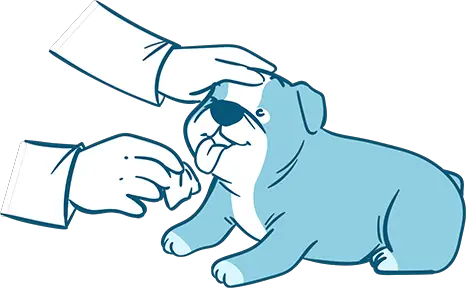 Tear stains can leave some bad looking marks right below the eyes of your puppy.
Tear stains can leave some bad looking marks right below the eyes of your puppy.
As a dog owner, you are probably interested in getting these taken care of as soon as possible.
One method that you can use to get rid of this is a probiotic that you can get from the vet. These will usually clear the issue right up as long as you give your puppy the right dosage.
There are also a few home remedies that you can choose that will help to combat the issue and prevent it from occurring again.
Take some cotton balls and soak them in some contact lens solution, picking some that are meant for sensitive eyes.
You can also check out this awesome article to find the best dog tear stains remover.
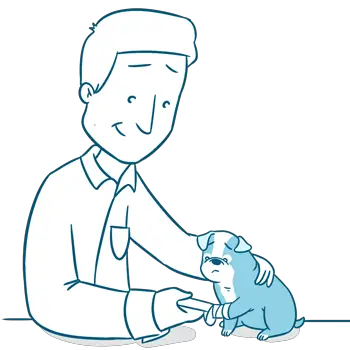 Bulldog Paw Problems
Bulldog Paw Problems
Just like any other dog, your bulldog can get some issues with their paws.
They put a lot of pressure on their paws to support their weight most of the time, especially when running around and being active.
It is essential to take them time keeping their paws in good working condition.
Here are some common issues that can happen in a bulldog’s paws:
- Yeast on the paw—this is a common thing if your puppy likes to lick, bite, or chew on their paws. They are more likely to develop this yeast during the humid and hot months and it can become really itchy for the dog. Make sure to bathe the dog each week in an anti-fungal shampoo and use this same shampoo to wash the paws each day. Add in some probiotics to your puppy’s diet as well.
- Cuts on pads—this can also happen by walking around your home. Considering a bulldog’s weight, and the pressure from walking will likely cause to open the wounds on their pad. When this happens, it is advisable to clean the area around, apply some antiseptic cream, wrap it in surgical gauze to keep the wound close.
- Grass seeds in the pad—getting a barley seed stuck in their paws is usually one of the biggest problems. It would be best to keep your dog’s fur reasonably short to see and remove the small objects easily.
- Other issues—whenever you see a cut, dry paws, bruise, any oozing, or other things that don’t look normal on a dog’s body, it would be best to take care of it right away to avoid complications, especially to a puppy.
Checking your dog’s paws often can avoid worsening the condition and doing a thorough check on their paws when grooming every time a good habit.
Always take time to provide proper care whenever they hurt their paws.
The Bulldog Tail

A bulldog’s tail is usually short tail bobs that hang low and follow the spine’s curvature towards their bottoms.
Some have small corkscrew tails that make them stiff and hard to move. Cleaning this is advisable to avoid infections and other problems.
It would be best to take some time to clean around the tail whenever you are bathing your bulldog.
Giving it a gentle rub and a bit of extra time is helpful, but it can be done quickly.
Cleaning the Bulldog Ear
A bulldog’s ear needs some special attention too.
This is an area that is often missed when groomed, which can lead to an ear infection.
When giving a bath and regular grooming procedures, make sure not to miss cleaning the ears.
It is essential to get an excellent cleanser for the ears. A veterinarian can help and show you how to clean the ear without harming it properly.
Rubbing the ears gives comfort to your dogs; it makes them happy! It also helps to get them used to the motions.
On a paper towel, add some cleanser liquid, start massaging slowly from the base of the ear, and move towards the other parts.
Some dogs may be uneasy when their ears are touched, but they will get used to it later on.
How to Treat Bulldog Ear Infection Naturally
Did you know that some bulldog owners glue their pet’s ears?
This is because bulldog ears are highly susceptible to ear infections. The natural structure of a bully’s ears makes them a breeding ground for fungi, yeast, and dirt, as well as moisture. These conditions can lead to bulldog ear infections which, needless to say, are very painful for your pet.
In this guide, we will tell you all the signs and symptoms of a bulldog ear infection. We will also cover some natural remedies for eliminating the infection and a few tips for their prevention.
Bulldog Ear Infection Symptoms
Here are the signs of ear infection in dogs:
- Waxy discharge
- Constant scratching of ears
- Red and inflamed ear canal
- General discomfort, crying, whining, whimpering
Thankfully, a dog ear infection need not always warrant a trip to the vet’s clinic.
There are some things you can do at home to naturally eliminate a bulldog ear infection.
Here they are:
Bulldog Ear Infection Home Remedies
Witch Hazel and Apple Cider Vinegar
Mix together an organic apple cider vinegar and a witch hazel in 1:1 ratio. Shake well to combine.
Dip a sterile cotton ball into the mixture and squeeze out the excess.
Gently wipe down your pet’s ear with this cotton ball.
The witch hazel will eliminate the infection and apple cider vinegar will restore balance to the ear.
You may want to repeat this dog ear infection treatment 2-3 times a day for a couple of days or until your bulldog no longer displays ear infection symptoms.
Aloe Vera
Aloe Vera is another one of the highly effective bulldog ear infection home remedies. It eliminates yeast, bacteria, and fungi and is free from any side effects.
Gently dab some pure aloe vera gel inside your pet’s ears. Let your pet lay down on the other ear so that the aloe penetrates into the ear canal. This way, the gel can work on the pathogens.
You may want to treat both the ears in order to completely eliminate the bacterial or dog ear yeast infection.
Make sure you only use high-quality, organic aloe vera gel free from parabens, preservatives, and colors or fragrances.
Olive Oil
At the first signs of ear infection in dogs, apply some warm olive oil into the ear canal. Olive oil soothes the inflamed ear and also brings out the bacteria, viruses, and other gunk inside the ear.
Warm the olive oil gently using a hot-water bath. Use a dropper to add the oil directly into the painful ear. Allow your pet to rest while the oil works. Repeat 2-3 times a day to see results.
Tea Tree Oil
Tea tree oil is one of the best natural remedies for cleaning bulldog ears. It has antibacterial, antiviral, and anti-inflammatory properties.
Make sure you use this remedy diluted since tea tree oil, when concentrated, is very strong.
Mix some tea tree oil with warm olive oil or coconut oil. Soak a sterile cotton ball with the mixture and use it to gently wipe your pet’s inner ear canal.
Repeat the remedy 2-3 times a day until you eliminate all the ear infection symptoms in your fur-baby.
Vitamin E
Cut open a vitamin E caplet and add a few drops of the vitamin E oil to a teaspoon of warm olive oil. Add in this mixture directly into your bully’s ears using a dropper.
Vitamin E is a powerful antioxidant that clears away the bulldog ear infection quickly and also helps you maintain your pet’s ear health.
Repeat this dog ear infection treatment once a day for 2-3 days or until the infection clears away completely.
Tips for Preventing Bulldog Ear Infections
These tips can help you prevent ear infections in your Bully:
- Inspect your dog’s ears twice weekly. This way, you can catch and eliminate any infection as soon as its signs manifest. Use the above home remedies to quickly eliminate the infection and prevent it from worsening.
- Clean out your pet’s ears regularly. You can use vet-approved drops or canine ear cleaners to maintain your pet’s ear health.
- Dry your bulldogs’ ears thoroughly after bath or swimming. Moisture inside the ears becomes a breeding ground for yeast and bacteria.
- Feed your pet a healthy diet. Often, food allergies can be responsible for recurrent ear infections in dogs. Speak to your vet to work out a balanced and optimal diet for your bully.
Visit a Vet Immediately if these Remedies Didn’t Work
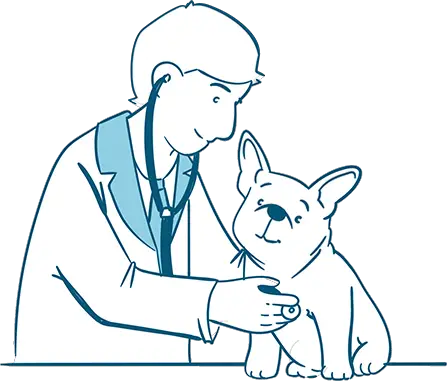 If your bulldog gets an ear infection, we hope that the above remedies help you eliminate it right away.
If your bulldog gets an ear infection, we hope that the above remedies help you eliminate it right away.
In case the above remedies do not show results after 2-3 days of use, take your pet to the vet right away. A dog ear infection is a serious matter. If left untreated, it can spread to the middle or inner ear causing damaging high fever.
In most cases though, the above natural dog ear infection treatment will surely work.
Let us know in the comments below which natural remedy worked best for your pet.
Bulldog Cropped Ears: What You Need to Know
 Bulldogs’ ears come in different shapes and sizes, much like other dogs. Even so, instead of treasuring their dog, many owners of special breeds desire to preserve their bulldog’s historic functional role by clipping their dog’s ears.
Bulldogs’ ears come in different shapes and sizes, much like other dogs. Even so, instead of treasuring their dog, many owners of special breeds desire to preserve their bulldog’s historic functional role by clipping their dog’s ears.
Cropping is the process of cutting one or more of the external flaps of the ear of the animal. Almost entirely done on dogs, this is an ancient procedure that was once conducted for supposed health, functional or aesthetic purposes. Bulldogs with cropped ears were formerly done as an “amusement” in dog fights and bull-baiting
Although those unfamiliar with the breeds claim that this is merely cosmetic, these techniques improve the dog’s ability to execute the duties.
Cropping Dog Ears: the Procedure
If anyone has decided to clip their bulldog’s ears, take note that it should only be accomplished by a trained and certified veterinarian. Here’s what you need to know:
- Bulldogs typically undergo ear cropping as early as 6 to 12 weeks old when the cartilage of their ear has not yet completely developed.
- Dogs are given an anesthetic and set to sleep.
- Dogs will have the external flap (half or full) of their ear cut off (along the nerve ends)
- The dogs will have to wear bandages for a few weeks.
- Dog’s bandages have to be examined and changed regularly
- It takes eight weeks for a dog to recover from surgery.
Bulldog Cropped Ears Aftercare Guidelines for Fast Recovery
The period of healing from the ear-cropping operation is likely to be unpleasant. Some veterinarians say that the ears would be particularly pain-sensitive for a couple of weeks, with certain dogs possibly having to experience intense ear pain. Problems that may arise from ear cropping include:
- Discomfort
- Ear infections
- The ears might not rise as wished.
- Excessive bleeding
- Vulnerability to infection
After an ear-cropping procedure, the veterinarian gives a series of guidelines on how to clean and take care of the Bully during the healing period. In most situations, veterinarians recommend antibiotics for at least ten days after surgery. It’s important to obey these directions regularly and to monitor your pet’s ears to ensure that they are healing well.
It is also important to always use the cone. This ensures that your bully won’t rip his stitches.
When you notice some scabs, remove them. Although it is not advisable to remove scabs on humans, like what you mommy instructed you to do when you were younger, it is different for bulldogs who had to undergo ear cropping. Scabs could interfere with the final shape of your dog’s ears if you do not get rid of them.
Cleaning is performed twice a day with Peroxide or Neosporin spray to alleviate pain, reduce inflammation, and avoid infections. Apply the triple-antibiotic cream to the stitches and wounds. This treatment should be continued until the stitches have been removed and the wounds are completely healed.
Are There Any Healthy Advantages to Cropping a Dog’s Ears?
Contrary to what people say, ear-cropping does not reduce the dog’s risk of having ear infections. About 80% of dogs never experience an ear infection, and this number covers all dogs, whether their ears are clipped or not.
Cropping the ears will not affect a dog’s hearing capacity. It’s a cosmetic operation for people trying to change the natural look of their pets.
Bulldog Cropped Ears FAQs
How much does it cost to have your dog’s ears clipped?
On average, you should expect to pay $150 to more than $600. Bear in mind that a more costly vet doesn’t always mean you’re going to get a good crop.
What are the most popular cropped ear styles for American Bulldog?
The most famous types for American clipped ears are:
- Show Crop – this style is the most common ear crop on American Bulldogs.
- Short Crop – It is ideally suitable for both American bulldog and Pitbull. It’s a mix of the Show and the Fight Crop.
- Battle Crop – Combat Crop style is the shortest of the three ear-cropping style It’s trendy among Bully fans, but wearing such kind of style leaves your pet’s ear more vulnerable to infections.
Ear cropping is primarily a reflection of American Bully and Pit bulls, as they have done in their ancestors. If you are considering getting your Bully’s ears cropped, you should get in touch with a licensed and skilled veterinarian to ensure protection and proper surgery. We do not recommend ear cropping. This debate is for educational purposes only.
Have you ever seen any ear cropping? Do you have your dog’s ears cropped? If you were to adopt a bulldog, would you prefer to get their ears cropped? Let us know in the comments.
Do Bulldogs Shed Much?
 Both kinds of bulldogs come from short hair breeds. This means that they don’t shed as much, mostly because they don’t have a lot of hair to lose.
Both kinds of bulldogs come from short hair breeds. This means that they don’t shed as much, mostly because they don’t have a lot of hair to lose.
You will need to maintain their hair, giving them regular grooming and keeping it short to avoid the hair coming off all over the place.
There will be a bit of shedding, but it won’t be as noticeable as you will find with some of the longer hair breeds.
7 Most Common Bulldog Skin Problems
 Bulldogs are very susceptible to skin problems owing to their deep wrinkles and skin folds, so if you notice your dog scratching or licking, or if you observe any hair loss, redness of the skin, or a rash, get your veterinarian to check your pet.
Bulldogs are very susceptible to skin problems owing to their deep wrinkles and skin folds, so if you notice your dog scratching or licking, or if you observe any hair loss, redness of the skin, or a rash, get your veterinarian to check your pet.
Thankfully, most bulldog skin problems can be cured or kept under control with simple treatments. Let us study common bulldog skin disease issues and their possible treatment options.
Common French and English Bulldog Skin Problems and Possible Solutions
1. Hot Spots
At first glance, hot spots may not seem very serious or warrant a trip to the vet. Hot sports are raw, oozy patches of skin and are created when your dog bites or licks an itchy spot or a bug bite.
You must treat hotspots on bulldog skin right away as failure to do so could lead to secondary skin infections. These are harder to treat and may even need antibiotics.
To treat hotpots, apply a dab of antibiotic cream on the hotspots. If your pet still continues to lick or bite the spots after 3-4 days of treating, you might need a prescription oral/topical antibiotic to treat it.
2. Chronic Facial Fold Pyoderma
Among the chronic English and French Bulldog skin problems, this one is very common.
French and English bulldogs often develop Pyoderma in the many folds of their skin near the tail or on their face. Dark and warm areas in the wrinkled skin give rise to bacterial or yeast growth causing itchiness, redness, and skin lesions.
You must carefully wipe down the wrinkles and skin folds regularly with a cloth to prevent this skin issue. If you notice lesions, apply a topical gel, antibiotic cream, or antifungal cream to prevent the infection from spreading.
3. Acne
Yes! Bulldogs can suffer from acne as well. If you notice zits popping up on your bulldog’s chin or abdomen, wipe the affected area with a moist, clean cloth.
Apply some benzoyl peroxide to the zits to prevent them from worsening.
4. Interdigital Cysts
If you’ve had a cyst, you know how painful that can be. Imagine how your pet feels when he has a cyst between the toes.
Bulldogs are prone to developing interdigital cysts. These pus-filled growths occur when the hair between the toes grows back into the skin causing severe pain and infection.
Place your buddy in a tub of warm water and add some Epsom salts to the water. Leave the paws soaking in this solution for 5-10 minutes. Wipe your pet dry and apply some antibiotic cream on the cysts.
Do not ignore this condition: it can worsen and cause severe pain to your pet.
5. Lick Granuloma
When a bulldog constantly licks a spot on the front or rear paws, it can become sore, raw, and painful and is known as a lick granuloma. The underlying conditions behind lick granuloma can range from allergies to fungal infections, to arthritis pain, to even cancer. It can also occur due to psychological issues like separation anxiety, boredom, etc.
Treat the licking process by using a lick-deterrent spray, or restraint collars, or even through veterinary acupuncture. In extreme cases, you might need a corticosteroid to stop the licking. Provide more exercise and human bonding to your buddy.
6. Demodectic Mange
The demodex canis mites are present on all dogs but if a dog has a weakened immune system, it can cause a severe allergic reaction. In bulldogs, demodectic mange can lead to scaly reddened skin, hair loss, pustules, plugged hair follicles, and intense pain and itching. In worse cases, Demodex can cause inflamed skin, enlarged lymph nodes, and secondary bacterial infections.
With early treatment, you can completely cure this bulldog skin issue. Use Goodwinol Ointment to treat mild cases.
7. Canine Scabies
Canine scabies is a common bulldog skin problem. This is a contagious skin disease that is passed from one infected dog to another.
Scabies mites burrow into the dog’s skin and lay eggs there. Symptoms include crusty pustules, hair loss, and severe scratching and biting which can lead to secondary skin infections.
Treatment for this painful bulldog skin problem includes medicated shampoos, miticidal dips, and an oral course of ivermectin. Your vet might also prescribe some anti-inflammatory medicines to make your pup more comfortable.
Keep Your Bulldogs Safe from Skin Problems
Bulldogs have a lot of love and joy trapped inside them but they also have a lot of skin. This excess amount of skin folds on all parts of the body and especially on the face, mouth, and near the tail.
This excess skin also rubs around and traps dirt and moisture creating the perfect condition for bacterial and fungal growth. This leads to bulldog skin problems like pyoderma, allergies, and dermatitis. The red and itchy skin can also smell really bad.
The best way to prevent bulldog skin problems like allergies, acne, eczema, and pyoderma is to clean the folds of the skin frequently.
Since most bulldog skin problems appear rather similar, make sure to get your pet checked to be diagnosed appropriately.
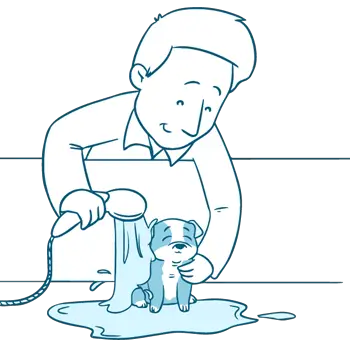 How to Clean Bulldog Folds and Wrinkles
How to Clean Bulldog Folds and Wrinkles
Bulldogs are wrinkly creatures and the older they get, the more the wrinkles are going to appear all over them.
When you are providing cleaning for your puppy, you need to make sure that you are also cleaning out the wrinkles.
It is easy for these areas to get a lot of food, dirt, and grime over just a few days, and ignoring this important area can make your dog get a bad infection.
So make sure that you work on just the wrinkles at least a few times each week, although if the issue gets really bad, you may need to do it each day.
The process of cleaning does not have to be difficult.
Take a damp cloth that is soft and wipe it through each of the wrinkles to get rid of the grime.
You can also do this when you are giving the puppy a bath, using some quality shampoo, just make sure that you completely rinse out the chemical so this doesn’t get stuck in the wrinkles as well.
For a quick wash when you are on the go, using Baby wipes that have aloe and lanolin can work well.
Or in these 3 tricks of cleaning bulldog wrinkles, we will show you helpful tricks to clean bulldog folds and wrinkles.
 Ways to Help the Bulldog Breathe Easier
Ways to Help the Bulldog Breathe Easier
Trouble breathing is one of the common issues to occur to bulldogs.
They are anatomical, through years of breeding and genetic manipulation meant to inhale less air than typical dogs due to their brachycephalic muzzle.
There are ways you can do to help your dog avoid breathing problems. Making sure to know if they have allergy problems a must thing to do.
They could be allergic to perfumes you use, scented products used around the house, or an air spray.
Observe your pup if they still get difficulty breathing after you have slowly eliminated any of the scented products. If the problem still occurs even without the scents, it is time to inform the veterinarian.
Illness can sometimes be a factor as to why your puppy is having trouble breathing. Some of these include:
- Heart disease—your vet will need to do a test in order to tell if there is a heart murmur that could be causing the breathing issue. Look for changes in behavior or loss of appetite in your puppy if this is an issue.
- Parainfluenza—this is like the flu in humans and can make breathing just as difficult for your puppy. Check for sneezing and a dry cough.
- Kennel cough—before boarding your dog, make sure that you get them vaccinated. This will help to avoid breathing issues from kennel cough.
Medical disorders are one of the reasons why they have breathing problems.
The always best treatment is to visit a veterinarian as they will do a thorough examination of the cause and how to diagnose it accurately.
It is essential to give your pet the best and right care to keep their health in good shape.
This chapter focused on the best ways on how to properly take care of your pup to live a healthy life.
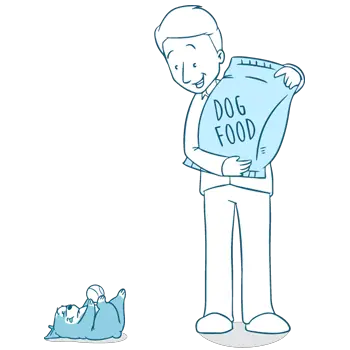 Feeding Your Bulldog Puppy
Feeding Your Bulldog Puppy
Proper feeding of your puppy is necessary if you want them to grow big and strong.
Feeding the bulldog the wrong kinds of food can make them feel sick and not grow and develop the way that they would like.
Here are some important things to keep in mind when you are figuring out what to feed your bulldog to give them the best health possible.
What Should Bulldogs Eat
One bad thing to do when picking the food for your bulldog is by randomly selecting dog food and choosing the cheapest one rather than the ones at average prices.
Most of this kind of food uses fillers a lot; adding grains that could be harmful to your pet, rather than putting meats, fruits, and vegetables.
It would be best to choose a dog food that has whole meat as its main ingredient.
The ingredients are often listed by the most massive grams. If you find that its first ingredient is meat, most of the food is composed of meat.
There may be several different types of meat listed on the label, make sure that they are whole meat and not a meat byproduct or filler.
Next is to look for fruits and vegetables for dogs. These provide a lot of vitamins and nutrients that your puppy needs to grow strong and stay healthy.
These should be pretty high up on the ingredient list to help your puppy get all the nutrition they need. It would be best to avoid any grains or wheat if possible.
Several brands are gluten-free, which can be perfect for your bulldog. It would be best to avoid dog food containing wheat and gluten, as some have allergies with this kind of ingredient.
When choosing a brand, pick the puppy variety for your puppy and switch to the adult version when they get older.
These have different concentrations of nutrients and other ingredients that are best suited for certain stages.
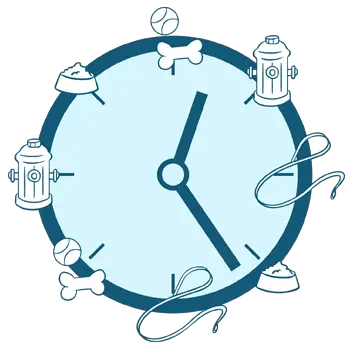 How Much Should a Bulldog Eat Each Day
How Much Should a Bulldog Eat Each Day
The amount that you feed your bulldog depends on their current stage.
Younger puppies and the ones in growing stages will need more food to keep up as their body changes. Older dogs will need enough for their body needs.
If you are breeding dogs, you will have to start feeding them more during the pregnancy once they get to this point.
Feeding them should be twice a day, usually once in the morning when they wake up and then around the time that you eat at night; always keep in mind that you should be the first to eat to assert your dominance.
You can also give dog treats throughout the day as a reward for good behavior or to help with your training sessions.
If you are giving many treats, make sure that you pick the ones with low fat and high vitamins. It helps them not to lose appetite for dinner and not gain much weight.
Most bulldogs weigh around 28 pounds or lower. If your dog is tipping the scales above this weight, you may need to cut back on the treats and try physical exercise to keep their health in good shape.
The Best Dog Food for My Bulldog Puppy
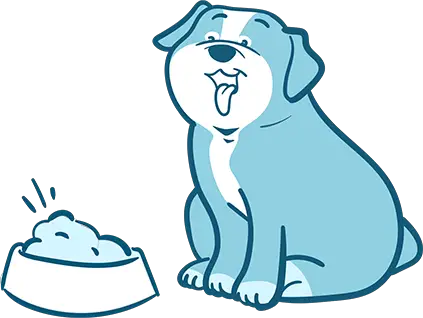 Choosing the right kind of dog food for your bulldog puppy is critical right from the beginning. This is going to ensure that the puppy is getting the proper nutrition right away and that you aren’t feeding them a bunch of junk that can add unwanted pounds and health problems to your puppy.
Choosing the right kind of dog food for your bulldog puppy is critical right from the beginning. This is going to ensure that the puppy is getting the proper nutrition right away and that you aren’t feeding them a bunch of junk that can add unwanted pounds and health problems to your puppy.
The top five dog foods that you should choose for your English bulldog include:
- Fromm Family Foods—these include formulas that are grain-free with lots of other quality ingredients. They have never been any recalls on the food and they add in probiotics to give your puppy some added help with their digestive tracts. Try the Pork and Peas or the Beef Frittata with your puppy.
- Nature’s Logic Pet Foods—this is another option that is gluten-free so you won’t have to worry about any stomach allergies from this. None of the vitamins are synthesized in this food so it all comes naturally from the ingredients.
- Nature’s Variety Instinct—this is a great brand to keep your puppy healthy, especially if they have yeast issues. There are also options that are great if your bulldog has a lot of allergies and needs to be on a limited ingredient diet.
- Go!—this company provides food that is human grade so you are getting nothing that is bad for the puppy. They include pre and probiotics to help with your puppy’s digestive health and some great omega oils to keep their coat and skin healthy.
- Acana Regionals—this food is high in protein but low in carbs, consisting of at least 60 percent meat and the rest comes from fruits and vegetables to keep your puppy healthy.
The top dog foods to feed your French bulldog include:
- Merrick—this food comes in a can and is often recommended by vets who like to take a more holistic approach to your dog’s health. There are plenty of vitamins and other great nutrients that come naturally in this kind of dog food.
- California Natural—this food is great for your French bulldog if they have skin or food sensitivity and need to be really careful about the foods they are eating.
- Acana—this food is really high in protein and fruits and vegetables, making it good for both the English and French bulldog.
- The Honest Kitchen—this is a good brand if your dog has a sensitive stomach to some foods or you feel that they are getting a bit gassy or have an upset stomach often.
Feeding your puppy the right kinds of food, from the moment you bring them home, can make a big difference in their overall health.
Consider these tips to ensure that your puppy is getting all the great food and nutrition that they need.
Watch What Your Bulldog Eats: Dangerous Foods Bulldogs Don’t Love
What your bulldog eats should be your highest priority if you wish to maintain their optimum health and happiness.
There are many human foods that can be downright dangerous to your bulldog.
And while we love our pets and want them to have the best, it does not mean that we can feed them anything.
In this guide, we will go over a list of foods that should never make it to the bulldog diet list. It is definitely a good idea to keep these foods out of your bully’s reach.
What Not to Include in the List if Dog Food for Bulldog
Chocolate
Chocolate is the biggest contender in the list of dangerous foods for bulldogs. If your French bulldog ate chocolate, he could get poisoned and suffer from vomiting, diarrhea, and even seizures. In large quantities, chocolate can be fatal to your bully.
If your pet has eaten a large amount of chocolate, take him to the vet right away. They will give your pet something to make him vomit it out.
Worry not: if your pet has eaten a tiny bit of chocolate, then it is alright. The toxins buildup over time and so a small amount should be OK.
Just make sure that you do not repeat the mistake. Keep all chocolates out of reach. (Better still, stop buying chocolate if you have a bulldog at home.) And please warn your kids about the consequences of feeding chocolates to bulldogs.
Raw Foods
Raw feeding French bulldog isn’t as cool as it was once thought to be. Some experts believe that raw chicken, eggs, fish, and meat can give dogs a healthier and shinier coat.
However, raw foods also increase the risk of salmonella poisoning. So, it is best to steer clear of raw foods.
Symptoms of salmonella in dogs are abdominal pain, diarrhea, nausea, and vomiting. Have these looked at by the vet right away!
Beverages Bad for Bullies – Milk, Coffee, Tea and Alcohol
Certain beverages should never make it to your French bulldog nutrition list as they can cause vomiting and diarrhea, and, in extreme cases, even death.
In fact, caffeine in tea and coffee is as bad as chocolate is to your bulldog.
As far as milk goes, most dogs are lactose intolerant and bullies are no different. Milk can cause bloating, flatulence, and foul-smelling farts in this breed. It is the leading cause of bulldogs and allergies which many novice pet parents may be unaware of. So, avoid feeding milk and cheese in large quantities.
Alcohol is one of the worst beverages to feed a bulldog. It can impact your bully’s heart and central nervous system, and in extreme cases, has even killed dogs. Thus, keep the drinks away from your pet.
Sultanas, Raisins, and Grapes
Even a single raisin and a few grapes have the power to kill a dog.
It is but natural that these foods are high up in the list of worst human food for French bulldogs.
If your bulldog eats these, he could suffer renal failure. Take him to the vet right away.
Onions
Onions can cause breathing trouble in bulldogs. Raw and cooked onions are both harmful for your Frenchie as they could trigger anemia in this breed.
So, never include onions in your bulldog food.
If your dog has any of the above foods, especially in large quantities, keep him under observation. If he shows any sign of discomfort, vomiting, diarrhea, or pain; take him to the vet right away.
It is a good idea to keep 3% hydrogen peroxide in the house to make your pet vomit out anything he isn’t supposed to eat. Carry the food along to the vet-whatever your pet has ingested. This will help your vet administer the right medicines. Even if your pet looks fine, it is important to have him looked at by the vet if he has had any of the above items.
Why Are Bulldogs So Expensive?
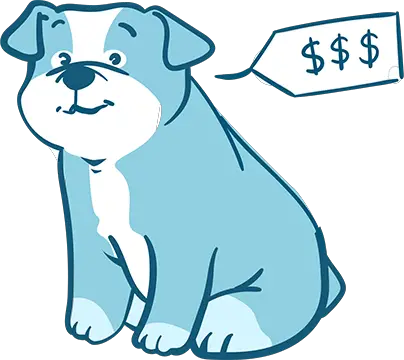 Compared to some of the other dogs that you can choose, the bulldog is usually expensive.
Compared to some of the other dogs that you can choose, the bulldog is usually expensive.
This is because it costs the breeder more to get the puppies ready to get to your home.
For example, bulldogs are not able to give birth naturally; they have to undergo C-sections. This is a costly procedure that requires a vet, rather than just having the puppies at home, and can add to your total cost of getting the puppy.
In addition, since the mommy dog had to go through this procedure, they are likely not capable of feeding the babies for a bit, meaning that the breeder will have to take over this job. This is a lot of time, effort, and formula to keep up with the puppies.
Add to this all the costs for raising the puppies, advertising them, and all the vaccines and other necessary vet work in your area, and the costs can add up quickly.
Usually, the breeder will have to pay at least $2000 just to have the puppies be born. This is why it can get so expensive to purchase the bulldogs from a breeder.
Should I Get a Bulldog?
There are so many great reasons to get a bulldog. This is a great dog that is going to be loyal and can stay around to grow with your family. Some of the best reasons to get a bulldog to include:
- Great with children—they are gentle and can play nicely with your kids, no matter what age.
- They enjoy playing—these are great dogs if you want someone who is full of energy and will play with them.
- They know how to take a break—while some dogs will play around all day long and never stop, bulldogs are fine sitting by you and taking a nap if you choose to lounge for the day.
- Stubborn—they never give up, which can go well when protecting you or your children.
- Love to be around people—they want to get your attention and they love to cuddle with you.
- Big softies—while these dogs may look scary to those not familiar with the breed, they are big softies who just want your love and to have fun with you.
Conclusion
Bringing a new puppy, especially a bulldog, into your home is a big commitment and you are sure to have a ton of questions on whether you are doing it right or not.
Bulldogs are special dogs and won’t be able to abide by all the same rules as other dogs; i.e. they will not do the best with a traditional collar and they are a bit more stubborn compared to some other dogs.
But with the right information to all your questions and some dedication that begins right when you bring them home, you will find that you and the bulldog can quickly build a bond that can never be broken.
Looking for more Bulldog tips, guides, and reviews?
- Top 6 Best Bulldog Beds For Your Lovely Pet: Useful Tips How To Choose
- A Helpful Guide For Choosing Your Pet’s Best Bulldog Life Jackets
- Best Food For Bulldogs – 7 Top Picks For Your Pet
- Best Bulldog Harness Buyer’s Guide: Make Outdoor Activities Safe And Fun
- Best Bulldog Wrinkle Wipes for Quickly Cleaning Your Lovely Pup
- 3 Amazing Tricks for Cleaning Bulldog Wrinkles
- Best Brush for Bulldogs: The Ultimate Helpful Guide

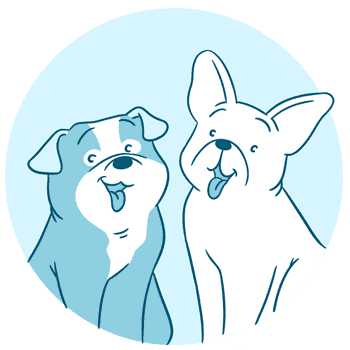
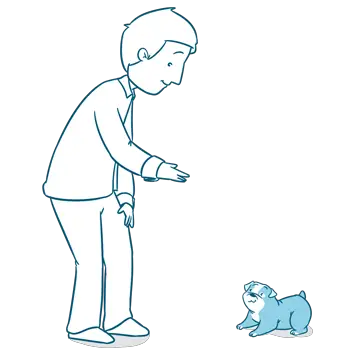

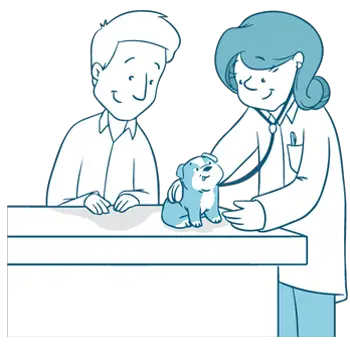
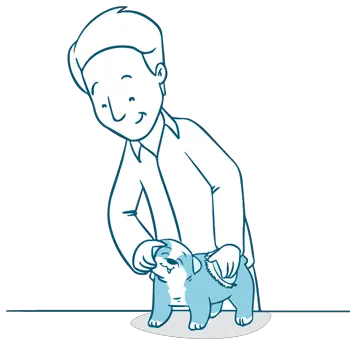
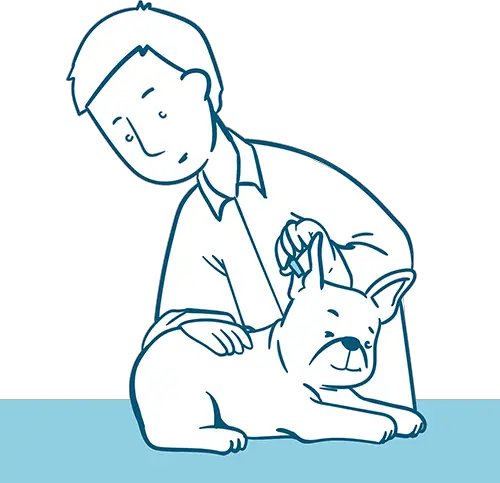

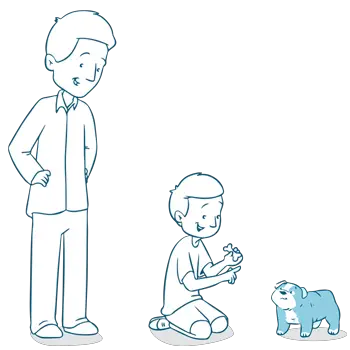
English bulldog has been itching constantly tomake long story short she’s 6 and has never had this problem before and just started about 6 months ago and she hasn’t stop and and NOTHING is helping I have took her to her original vet that she has been to since she was a baby at first they said it was an infection, then said it was her anal glands and then said she was born with it she will just be sleeping soundly and all of a sudden jump and start running